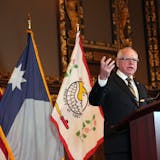Colleague Eric Roper this week told readers that Minneapolis officials are calling for changes to Olson Hwy. for the Bottineau light-rail line that would make it less hostile to people on foot.
But the city has been down this road before.
Fifteen years ago, the master plan for redeveloping the area of the old North Side housing projects called for much the same thing. According to City Hall habitues with long memories, the push to make the Olson corridor more friendly to foot traffic was deep-sixed by pro-car-commuting Republican state officials.
Here's the description from the plan: "The proposed reconfiguration, with design features drawn from Summit Avenue in St. Paul, will widen the median and add curvature to the roadway. The intent is to slow traffic, create a formal green gateway to downtown, and create an address for the neighborhood."
The idea was to make it easier for pedestrians to make it across the seven-lane roadway, to give them a more substantial refuge on the median, and to discourage traffic from exceeding the frequently broken 35 mile-an-hour speed limit. The 2000 plan also looked ahead to light-rail riders, saying that a wider median would allow easier implementation of rail transit.
What happened? "There was a pushback from Republican legislators that represented places further west that they did not support that," said Chuck Lutz, deputy director of the city's development agency and the owner of one of City Hall's best and longest memories. Republicans controlled the Minnesota House for the half-decade after the plan was adopted, as they do so this session. They had an ally in Lt. Gov. Carol Molnau, who doubled as transportation commissioner.
"She was not supportive at all of any kind of traffic-calming issues at that time," Lutz said. He said he's gratified that taming Olosn has been resurrected. MPLS has reached out to Molnau and will update this post if she responds.
Much like Interstate 94, which wiped out the historically black Rondo area in St. Paul in the 1960s, the original construction of Olson after its namesake's death wiped out an area that represented the commercial heart of the North Side black community along 6th Avenue N.



